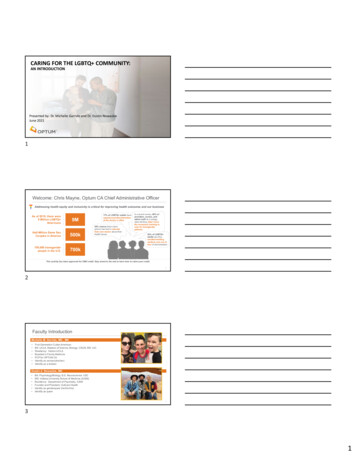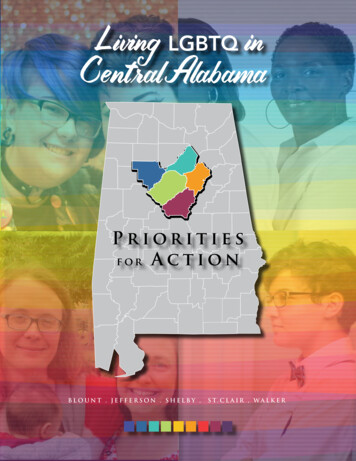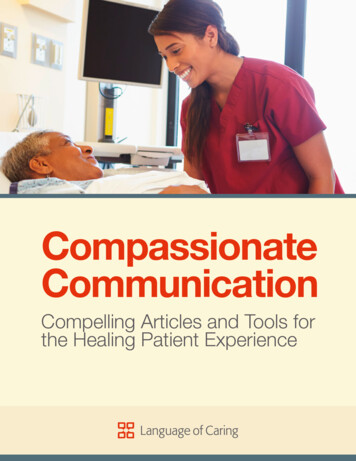
Transcription
CARING FOR THE LGBTQ COMMUNITY:AN INTRODUCTIONPresented by: Dr. Michelle Garrido and Dr. Dustin NowaskieJune 20211Welcome: Chris Mayne, Optum CA Chief Administrative OfficerAddressing health equity and inclusivity is critical for improving health outcomes and our businessAs of 2019, there were9 Million LGBTQ Americans17% of LGBTQ adults haveexperienced discriminationat the doctor’s office9MHalf-Million Same SexCouples in America500k700,000 transgenderpeople in the U.S.700k29% chance that a transperson has had to educatetheir own doctor about theirhealth issuesIn a recent survey, 80% ofproviders, nurses, andadmin staff at a urologyclinic felt they didn’t havethe necessary training tocare for transgenderpatients20% of LGBTQ adults say theyavoided seekingmedical care out offear of discriminationThis activity has been approved for CME credit. Stay tuned to the end to learn how to claim your credit.22Faculty IntroductionMichelle M. Garrido, MD , MS First Generation Cuban AmericanBS: UCLA, Masters of Science, Biology: CSUN, MD: UICResidency: Harbor-UCLABoarded in Family MedicinePCP for OPTUM CAIdentify as woman(she/her)Identify as a lesbianDustin Z. Nowaskie, MD BA: Psychology/Biology, B.S. Neuroscience: USCMD: Indiana University School of Medicine (IUSM)Residency: Department of Psychiatry, IUSMFounder and President, OutCare HealthIdentify as genderqueer (he/him/his)Identify as queer331
OutCare HealthOutCare is thenation’s firstcomprehensiveresource forLGBTQ healthcare44Learning Objectives1Learn respectful use of terminology and pronouns2Understand differences between gender identity and sexual orientation3Understand systemic barriers to adequate health care that sexualand gender minorities face4Discuss relevant clinical applications55LGBTQ Terminology and PopulationDr. Dustin Nowaskie62
Terms, terms, and more termsNon-Heterosexual Terms AbrosexualAce spectrumAegosexualAndrosexualAsexualAsexual lesbianBiromanticBiromantic homosexualBisexual polyamorousDemisexualGraysexualGreyromantic demisexualGynedemisexual antic asexualPansexualPolysexualQueerQueer demisexualQuestioningSapiosexualSapphicSexually fluidNon-Cisgender Terms AgenderAgender th gendersBoy fluxDemiboyDemigirlFemale genderfluxGender apatheticGenderfluidGenderfluid nonbinary Gender neutralGenderqueerGray minineTrigenderTwo spirited55 Terms on this slide alone!77LGBTQ LLesbianGGayBBisexualTTransgenderQQueer Other sexual and gender minority people88Sexual OrientationSexual Orientation tells you how a person characterizes theirsexual & emotional attraction to othersCommon words to describe sexual orientation:Heterosexual/straight, gay,lesbian,bisexual, asexualAVOID: homosexual,and ‘sexual preference’Questioning orQueerDescribes a person whois not exclusivelyheterosexualPansexualSexual attraction,romantic love, oremotional attractiontoward people of manyor all sex or genderidentitiesSexualBehaviorSexual expressioneither physically and/oremotionally for exampleMSM & WSW993
Gender IdentityGender Identity tells you how a person identifies their internalsense of themselvesCommon words to describe gender identity:CisgenderTransgenderCisgender Man: sexassigned at birth was maleand identifies as a manCisgender Woman: sexassigned at birth was femaleand identifies as a womanTransgender Man: sexassigned at birth was femaleand identifies as a manTransgender Woman: sexassigned at birth was maleand identifies as a womanGenderExpressionGenderAffirmationHow one presentsthemselves throughbehavior, mannerisms,speech patterns, dress,hairstyles, etcThe process by which onesupports their gendersocially and/or medicallyAVOID: hermaphrodite, transgendered, a transgender, tranny, transvestite, sex change1010Poll Questions (Anonymous) – Check All That ApplyHow do you Identify yoursexual tLesbianGayBisexualQueerPansexualAsexualPrefer not to discloseOther (if other, please enter freetext)What percentage of the USpopulation identifies asLGBTQ ?A.B.C.D.2%5%10%20%1111LGBTQ YouthSexual Orientation of LGBTQ YouthGender Identity of LGBTQ Youth12124
Sex, Sexual Orientation, and Gender IdentitySexual Orientation of Transgender PeopleAsexual15%10%Bisexual14%Gay, lesbian, or same gender21%Other16%18%Transgenderpeople can be anysexual orientationPansexual6%Gender identitydoes not equalsexual orientationQueerStraight or heterosexual1313Poll Questions (Anonymous)Have you faced discrimination?A. YesB. NoWhat types of discrimination? (Check all that apply)A.B.C.D.E.F.G.Gender identitySexual orientationRace/ethnicityReligious/ politicalAgeNone; N/AOther (if other, please enter free text)1414Prevalence and StigmaPREVALENCE IN THE U.S.MARGINALIZATION & DISCRIMINATION 5.6%*5.6 % of the U.S. populationidentifies as LGBT50%50% LGBTQ adults endureinterpersonal discriminationincluding slurs, microaggressions,sexual harassment, and violence15.9%*15.9% of Generation Zidentifies as LGBT20%20% LGBTQ identified patientssuffer from discrimination inhealthcare environmentsEstimates can greatly vary, likely secondary tosocial and healthcare discrimination*Gallup (2020)Patients experience high rates of refusal ofessential medications and may be exposed toverbal and physical violence during physicalexaminations15155
Clinical ApplicationsDr. Michelle Garrido16Case #1: Patient Calls to Schedule an Appointment You are a patient support representative responsible for answering phone calls. A new patient is calling to schedule their first appointment. You pull up thepatient’s file and after verifying what’s noted in the chart as “male” for sex atbirth, you ask, “How can I help you today, sir?” The patient corrects you that they identify as a woman and goes by a differentname.1717Poll Questions (Anonymous)You have accidentally mis-gendered someone (i.e. used the wrong name orpronoun). What is the next best step?A. Say nothing! If it’s not acknowledged, then it didn’t happenB. ApologizeC. Report yourself to HR and ask for a reprimandD. Stay educated and conscious of your languageRemember that everyone makes mistakes!18186
Recommendations If you make a mistake regarding someone’s identity, acknowledge the mistake/apologize,be honest with your familiarity, and ensure the person that moving forward you will usethe correct pronoun. “I apologize. I’ll make sure to use the correct name or pronoun moving forward.” Update the patient’s file or chart: Make a note of the name patient wants to be called. Document patient’s gender identity and pronouns. If you are unsure of someone’s identity, ask and don’t assume. Ask the person how they want to be called.1919Case #2: Patient Presents at Clinic for Appointment You are a medical assistant who is about to room the next patient for theirdoctor’s appointment at an outpatient clinic. You notice the patient is new to the clinic, so you look at the patient’sdemographic information in the chart. You notice that the patient’s sex at birth is“male,” and gender identity is “female”. You walk into the lobby and notice one patient who is seated. You call out for“Mr. Jones”.2020Poll Questions (Anonymous)How can we ask a patient about their gender identity?A.B.C.D.E.What is your name?What are your pronouns?The chart says you’re male, so you must be.Here. Fill out some forms. Please bring back my pen.Nice to meet you. Can you confirm your name and pronouns?21217
Recommendations Make it a habit to check the patient’s chart and update it on a regular basis. A person’s sexual orientation and gender identity can change. If a patient is taking the time to inform you, take the time to document and verify patientinformation. Avoid using sir, ma’am, mister, misses, etc.22Case #3: Clinician You are a clinician about to see a new patient. The patient is roomed. Vitals arenormal. You notice that the patient’s sex at birth is male and gender identity is female. As you review medical and social history with the patient, patient reports thatthey are “socially” transitioning but has not used hormones or had any surgicalinterventions. Normal formative history and milestones either early or on-time.Finishing final year of high school and will be attending college out-of-state next year.Sexually active since age 14 and has had sex with females and males. Four sexual partners.Protected intercourse. Identifies as gay.2323Poll QuestionsGender identity and sexual orientation are different parts of a person’s identity.A. TrueB. FalseGender identity and sexual orientation can change over a person’s lifetime.A. TrueB. False24248
Recommendations If you misgender someone: acknowledge, ask, update Read chart, update as needed Sexual Orientation and Gender Identity are different features of a person’sidentity2525Why Is This of Societal Importance?As an organization, our goal is to treat all patients and provide equitable access to everyoneBarriers to care:EVERYONE NEEDS ACCESS TO SAFE, RELIABLE HEALTH CARE15% Legal: Lack of/shifting legalprotections against discrimination inhealth carevs.of transgender peoplelive in poverty4%of the generalpopulation19% of transgender people report lacking any form ofhealth insurance including Medicaid Medical providers: Limited access tocompetent providersSelf-medication is dangerous: Unsupervised hormone usecan lead to serious liver problems, blood clots, stroke, andincreased HIV and Hepatitis risk Implicit and explicit biasesWH E N TR AN S P E OP LE GE T TH E C AR E TH E Y N E E DOVERALL MENTALHEALTH IMPROVESSUCICIDE RATESDROP DRASTICALLYMEDICAID MONEYIS SAVED26Why Is This Clinically Important?The LGBTQ Community faces specific risk factors and has clinical needsunique to their populationRisk Factors: Mental health: Risk of major depression, anxiety disorders, and suicide Sexual health: Reproductive organs and preventive care Preventive care: Rates of poor physical health, activity limitation, chronic disease(heart disease, cancers) Substance use: Risk of substance abuse issuesClinical Considerations: Need for referrals to endocrine, plastics, GYN, urology, psychiatry279
Why Is This Clinically Important?The LGBTQ Community suffers from especially high rates of mental health issues,increasing the need for a provider / medical group that they can trustLGBTQ Individuals and Mental HealthLGBTQ Individuals and Suicide12SexualOrientation% ConsideredSuicideHeterosexual2.3%108LGBTQ Individuals and Mental r# DaysDepressed# DaysAnxiousLGBTQ Individuals and 30.8%28Next Steps for OptumLLiaiseGGather InformationBBe SensitiveTTalkQQuote Us!2929ClosingDr. Michelle Garrido and Dr. Dustin Nowaskie3010
Learning Objectives & Key Takeaways1Learn respectful use ofterminology and pronounsAsk questions! It’s ok to make mistakes!2Understand differences betweenGender Identity & Sexual OrientationTwo separate elements of a person’sidentity3Understand systemic barriers thatsexual and gender minorities faceLGBTQ community is a diverse group ofindividuals, united by a common history ofrepeated historical discrimination andvictimization, who also require a specializedand sensitive clinical approach4Discuss relevant clinicalapplicationsKeep learning!3131Contact information:Michelle Garrido, M.D, M.S.Physician, Optum in Nowaskie, M.DFounder, OutCare g3232Reference Materials National Survey on LGBTQ Youth. 2020. The Trevor Project. National Survey on LGBTQ Youth Mental 0/ UCLA Williams Institute: on/lgbt-stats/?topic LGBT#density Gallup 2020: 5.6% ation-rises-latest-estimate.aspx Casey LS, Reisner SL, Findling MG, Blendon RJ, Benson JM, Sayde JM, et al. Discrimination in the United States: Experiences of lesbian,gay, bisexual, transgender, and queer Americans. Health Serv Res. 2019;54(Suppl 2):1454-1466. doi: 10.1111/1475-6773.13229 Ayhan CHB, Bilgin H, Uluman OT, Sukut O, Yilmaz S, Buzlu S. A systematic review of the discrimination against sexual and gender minorityin health care settings. Int J Health Serv. 2020;50(1):44-61. doi:10.1177/0020731419885093 Baker KE. Findings from the behavioral risk factor surveillance system on health-related quality of life among US transgender adults, 20142017. JAMA Intern Med. 2019. doi: 10.1001/jamainternmed.2018.7931 Wallace BC, Santacruz E. Health disparities and LGBT populations. In: Ruth R, Santacruz E, editors. LGBT Psychology and Mental Health:Emerging Research and Advances. Santa Barbara, CA: Praeger; 2017. p. 177-196. ISBN:9781440843372. Wallace BC, Santacruz E. Health disparities and LGBT populations. In: Ruth R, Santacruz E, editors. LGBT Psychology and Mental Health:Emerging Research and Advances. Santa Barbara, CA: Praeger; 2017. p. 177-196. ISBN:9781440843372. https://www.wpath.org/ ing-with-lgbtq-patients333311
To claim continuing education credits and/or receive yourcertificate of attendance, please 021-liveIf you were pre-registered for this session, you will receive an email shortly with this link and instructions.3412
Clinical Applications Dr. Michelle Garrido Case #1: Patient Calls to Schedule an Appointment You are a patient support representative responsible for answering phone calls. A new patient is calling to schedule their first appointment. You pull up the patient's file and after verifying what's noted in the chart as "male" for sex at











